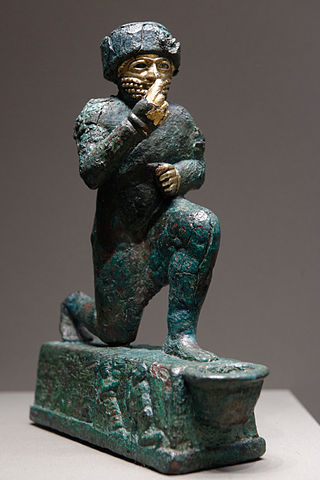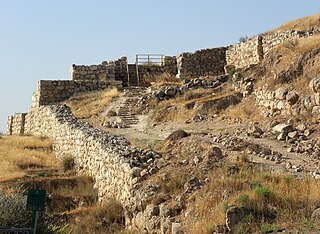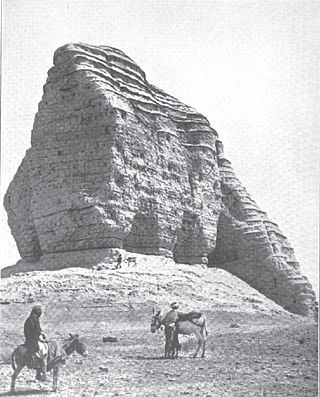
James Buchanan Nies (22 November 1856 - 1922) was an American episcopal minister and Assyriologist. [1] He was president of the American Oriental Society in 1921. [2]

James Buchanan Nies (22 November 1856 - 1922) was an American episcopal minister and Assyriologist. [1] He was president of the American Oriental Society in 1921. [2]

Larsa, also referred to as Larancha/Laranchon by Berossos and connected with the biblical Ellasar, was an important city-state of ancient Sumer, the center of the cult of the sun god Utu. It lies some 25 km (16 mi) southeast of Uruk in Iraq's Dhi Qar Governorate, near the east bank of the Shatt-en-Nil canal at the site of the modern settlement Tell as-Senkereh or Sankarah.

The Kassites were people of the ancient Near East, who controlled Babylonia after the fall of the Old Babylonian Empire c. 1531 BC and until c. 1155 BC.

Lachish was an ancient Canaanite and Israelite city in the Shephelah region of Israel, on the south bank of the Lakhish River, mentioned several times in the Hebrew Bible. The current tell (ruin) by that name, known as Tel Lachish or Tell ed-Duweir ,, has been identified with the biblical Lachish. Today, it is an Israeli national park operated and maintained by the Israel Nature and Parks Authority. The park was established on lands of the depopulated Palestinian village of Qobebet Ibn ‘Awwad which was north of the Tel. It lies near the present-day moshav of Lakhish.
James Henry Breasted was an American archaeologist, Egyptologist, and historian. After completing his PhD at the University of Berlin in 1894, he joined the faculty of the University of Chicago. In 1901 he became director of the Haskell Oriental Museum at the university, where he continued to concentrate on Egypt. In 1905 Breasted was promoted to full professor, and held the first chair in Egyptology and Oriental History in the United States.

The Lament for Ur, or Lamentation over the city of Ur is a Sumerian lament composed around the time of the fall of Ur to the Elamites and the end of the city's third dynasty.

The Cyrus Cylinder is an ancient clay cylinder, now broken into several pieces, on which is written a Achaemenid royal inscription in Akkadian cuneiform script in the name of Persian king Cyrus the Great. It dates from the 6th century BC and was discovered in the ruins of the ancient Mesopotamian city of Babylon in 1879. It is currently in the possession of the British Museum, which sponsored the expedition that discovered the cylinder. It was created and used as a foundation deposit following the Persian conquest of Babylon in 539 BC, when the Neo-Babylonian Empire was invaded by Cyrus and incorporated into his Persian Empire.

Lullubi,Lulubi, more commonly known as Lullu, were a group of tribes during the 3rd millennium BC, from a region known as Lulubum, now the Sharazor plain of the Zagros Mountains of modern Iran, Lullubi was neighbour and sometimes ally with the Simurrum kingdom. Frayne (1990) identified their city Lulubuna or Luluban with the region's modern town of Halabja.

Morris Jastrow Jr. was a Polish-born American orientalist and librarian associated with the University of Pennsylvania.
The Dynasty of Isin refers to the final ruling dynasty listed on the Sumerian King List (SKL). The list of the Kings Isin with the length of their reigns, also appears on a cuneiform document listing the kings of Ur and Isin, the List of Reigns of Kings of Ur and Isin.

Akshak was a city of ancient Sumer, situated on the northern boundary of Akkad, sometimes identified with Babylonian Upi.

Albert Tobias Clay was an American professor, historian and Semitic linguist. He was professor of Assyriology and Babylonian Literature at Yale University and served as founding curator of the Yale Babylonian Collection.
Paul-Alain Beaulieu is a Canadian Assyriologist, a Professor of Near and Middle Eastern Civilizations at the University of Toronto.

Kurigalzu I, usually inscribed ku-ri-gal-zu but also sometimes with the m or d determinative, the 17th king of the Kassite or 3rd dynasty that ruled over Babylon, was responsible for one of the most extensive and widespread building programs for which evidence has survived in Babylonia. The autobiography of Kurigalzu is one of the inscriptions which record that he was the son of Kadašman-Ḫarbe. Galzu, whose possible native pronunciation was gal-du or gal-šu, was the name by which the Kassites called themselves and Kurigalzu may mean Shepherd of the Kassites.

George Aaron Barton was a Canadian author, Episcopal clergyman, and professor of Semitic languages and the history of religion.

The Kesh temple hymn, Liturgy to Nintud, or Liturgy to Nintud on the creation of man and woman, is a Sumerian tablet, written on clay tablets as early as 2600 BCE. Along with the Instructions of Shuruppak, it is the oldest surviving literature in the world.

Sîn-kāšid was the king of the ancient Mesopotamian city of Uruk during the first half of the 18th century BC. His precise dating is uncertain, perhaps ca. 1803–1770 BC corresponding to ca.1865–1833 BC, but likely to have been fairly long due to the voluminous building inscriptions extant for which he is best known and contemporary with Nur-Adad of Larsa and Enlil-bāni of Isin. His apparent lack of relationship with any of the preceding rulers of Uruk and his omission of mentioning his father in any of his inscriptions has led to the belief that he was the founder of a dynasty. He participated in a diplomatic marriage with Šallurtum, the daughter of Sūmû-la-Il, the second king of the First Babylonian Dynasty, as her name and epithets appear in the seal impressions of three clay bullae recovered from the remains of his palace.
F. W. "Chip" Dobbs-Allsopp is a biblical scholar, epigrapher, and literary theorist. Currently professor of Old Testament, or Hebrew Bible, at Princeton Theological Seminary, he has taught and written extensively on Semitic languages, the origins of alphabetic writing, biblical poetry, poetics, and literary criticism.
Nebuchadnezzar II's Prism, also known as the Hofkalender, EŞ 7834, The Court of Nebuchadnezzar, the Unger Prism, Nebuchadnezzar's Court Calendar, the Phillipps Cylinder, Nbk Zyl III,4, C34, and Nr. 9, is an artifact from the Neo-Babylonian Empire. The text is similar to, but different from, the Nebuchadnezzar cylinder C34, also known as the Middle Hill cylinder.

The Palestine Oriental Society was a society for the "cultivation and publication of researches on the ancient Orient", founded on the initiative of Albert T. Clay in Jerusalem in 1920. It was established at a time when control of Palestine had recently passed from the Ottoman Empire to the British following the end of the First World War, and when archaeology was being professionalised and modernised.